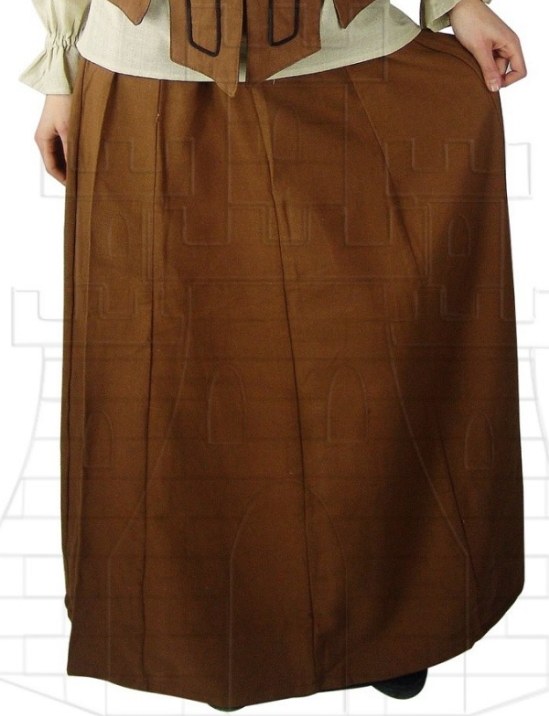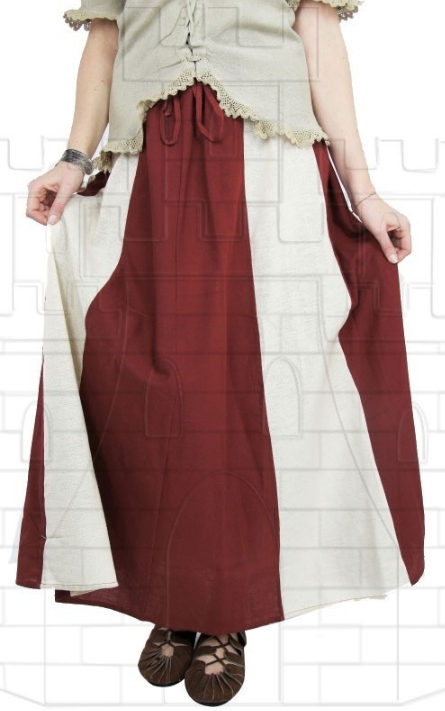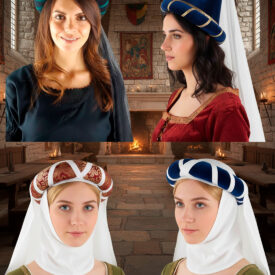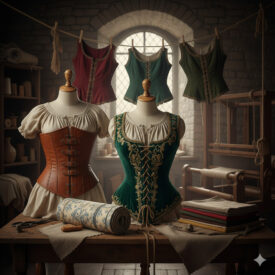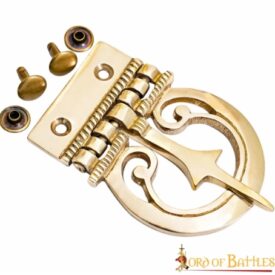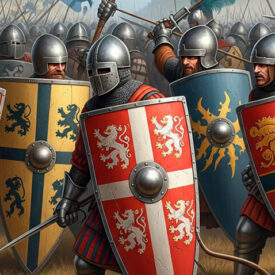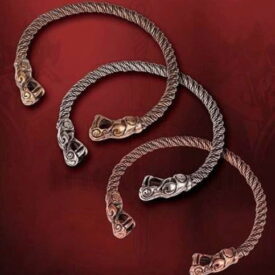Fashion is an intrinsic reflection of society, and few garments embody this truth as clearly as medieval skirts. Far from being mere pieces of fabric, these garments formed a complex system of visual communication, capable of revealing the wearer’s social status, occupation, and even moral values. Let us delve into the fascinating and often underestimated world of skirts in the Middle Ages and discover their profound evolution, the materials that composed them, their cultural significance, and, finally, their surprising resurgence in our times.
The medieval skirt, in its most basic conception, was a garment that hung elegantly from the waist and covered the legs, varying dramatically in design and opulence depending on the era and the wearer’s social position. Some of the medieval skirts worn by noble ladies reached astonishing dimensions, exceeding three meters in diameter at the base, a testament to the wealth and power of their owners.
The Medieval Skirt: From Simplicity to Sophistication
At the dawn of the Middle Ages, women’s clothing was characterized by notable simplicity. Tunics were long and loose, flowing down to the ankles, prioritizing comfort and modesty over ostentation. However, as the Middle Ages progressed, especially during the 14th and 15th centuries, the female silhouette underwent a radical and truly spectacular transformation. This change was not isolated; it was partly inspired by the evolution of men’s clothing, which leaned towards more fitted and defined shapes. Women, consequently, began to adopt a style that more tightly embraced the torso and marked the waist with unprecedented elegance.
This new fashion trend gave rise to skirts with extraordinarily generous fullness, which spread majestically from the hips, often trailing on the ground in long and sumptuous trains. This trailing was not an inconvenience, but rather a mark of elegance and a clear indicator of status for the ladies of the time, as it implied they did not perform manual labor. The upper part of the dress, in contrast, was designed to be small and fitted, creating a striking visual contrast with the wide and voluminous lower skirt. To achieve the desired fit and slender silhouette in the torso, garments were meticulously made in parts, often lined with wadding or cotton, materials that helped stretch the fabric and maintain the desired shape in the bodice. The hems, crafted with great precision at the bottom of the skirts, not only provided a clean and aesthetic finish but also added weight, contributing to the majestic movement of the garment.
Openings and necklines also evolved over time, moving from more conservative horizontal lines to bolder “U” or “V” shapes, sometimes combined with delicate ruffs or high collars for a touch of sophistication. Buttons, which until then were rudimentary ribbons or cords, became hugely popular, not only as functional elements to close sleeves and fronts but also as decorative adornments that enhanced the richness of the dress. The placement of the belt, a key accessory, also varied: it could be fastened at the waist to emphasize the figure or fall lower on the hips, used both to gather the skirt and add volume or to subtly define the silhouette. The sleeves, meanwhile, became a true canvas for fantasy and creativity, with shapes ranging from narrow and fitted to extremely wide, known as “lost” or “bell” sleeves, which added drama and movement to the attire.
By the 16th century, the concept of the skirt for common people, especially in rural areas, was more pragmatic and functional. It essentially consisted of a rectangular piece of fabric, often wool or linen, with a hole in the center to fit the waist. This adjustment was achieved with a simple belt or, in many cases, with a cord, so that the fabric hung forming four distinctive points. Over time, this basic form was refined to make it more stylish and body-adapted, incorporating or removing pleats as needed and according to local fashion, always seeking greater comfort and a neater appearance within economic limitations.
Fabrics and Dyes: The Language of Dress and Social Status
The choice of materials for making medieval skirts was by no means random; on the contrary, it directly and forcefully reflected the social and economic status of the wearer. Every fiber and every color told a story, a visual narrative about the wearer’s position in the medieval hierarchy.
Common and Luxury Materials:
- Wool: Undoubtedly the most common and extraordinarily versatile fabric of the Middle Ages, used by virtually all social classes, from the humblest peasant to the most opulent noble. Its popularity lay in its inherent properties: it was warm, notably water-resistant, and crucially, easy to dye, allowing for a wide range of colors. Wool served for everything, from the simplest and most functional peasant tunics, designed for daily work and protection from the elements, to the most elaborate and luxurious noble cloaks, adorned with embroidery and precious linings. It is important to note that wool quality varied greatly; while coarse wool was accessible, fine merino wool, imported from places like Spain, was highly prized and thus extremely expensive, reserved for the elite.
- Linen: This material, light, breathable, and surprisingly durable, was the ideal choice for underwear and layers worn directly on the skin, especially vital in warm climates or during summer months. Its ability to absorb moisture made it very comfortable. In addition to underwear, linen was also used for finer outerwear and petticoats, which not only provided an extra layer of warmth in winter but also contributed significantly to the volume and desired shape of skirts, especially as fashion dictated wider silhouettes. Flemish linen, known for its exceptional quality and fineness, was particularly valued throughout Europe.
- Cotton: Although less prevalent than wool and linen in most of medieval Europe, cotton was used for simpler, everyday garments in certain regions. For much of the Middle Ages, it was considered an exotic luxury in Europe, imported from warmer regions, and its widespread use would not be consolidated until the end of the medieval period and the beginning of the Modern Age.
- Silk and Brocade: These were, without a doubt, the most luxurious and coveted materials, strictly reserved for the nobility, royalty, and the highest classes of society. Silk, originally imported from China via the Silk Road, was so valuable that its price sometimes equaled that of gold, reflecting the immense effort and dangers associated with its transport. Silk brocades, often interwoven with intricate gold and silver threads, were sumptuous and heavy garments that were not only incredibly expensive but also considered family treasures, inherited from generation to generation as symbols of wealth and lineage.
- Velvet: Another rich and expensive fabric, velvet was the preferred choice of the nobility and upper bourgeoisie for their most formal skirts and dresses. Its soft and luxurious texture, often combined with elaborate lace and intricate embroidery, made it a statement of opulence and good taste.
- Fur and Leather: Although not used for main skirts, fur and leather were fundamental for outer garments such as capes, jackets, and a variety of accessories, including gloves and hats. These materials offered superior protection against cold, wind, and rain, and their quality and the type of animal they came from (for example, ermine or sable versus sheepskin) were also unmistakable symbols of status and wealth.
The Meaning of Colors:
The color of fabrics was not merely aesthetic; it conveyed a deep and often symbolic meaning. Natural dyes, obtained from a variety of sources such as plants (indigo for deep blue, madder for vibrant red), minerals (alum, essential for fixing and enhancing colors; cinnabar for intense and bright reds), and even insects (cochineal or kermes to produce rich reds and purples), determined the color palette available at the time. The brightest, most saturated, and most durable tones were an exclusive luxury, reserved for nobles and the high clergy, due to their high cost and the complexity of their production.
- Red: Symbolized power, nobility, love, and sometimes blood and war. It was a color of great prestige.
- Blue: Deeply associated with the Virgin Mary, blue was linked to fidelity, truth, and piety. It was a popular color among the nobility, especially the French.
- Green: Represented youth, hope, nature, and fertility. It was a common color for everyday and hunting attire.
- White: A symbol of purity, innocence, and virtue. It was worn on special occasions and by members of religious orders.
- Black: Although in the early medieval centuries it was less common as a main color, by the end of the Middle Ages, black was associated with austerity, dignity, seriousness, and mourning. It gained popularity among the bourgeoisie and nobility in the 15th and 16th centuries.
Medieval Skirts and Social Identity
Women’s clothing in the Middle Ages was an extraordinarily complex and detailed visual code that revealed, without words, a woman’s position in society. Every element, from the fabric to the adornment, contributed to this narrative. Fashion was also intrinsically influenced by a woman’s age and marital status. For example, girls and maidens (young unmarried women) could wear their hair loose, often braided or decorated, as a sign of their youth and availability. In contrast, married women, out of decorum and social custom, had to cover their hair with wimples, veils, or caps, a practice that symbolized their modesty and new status.
Professions also had their distinctive attire, which allowed for quick identification of a person’s occupation in the bustling medieval life. A baker, for example, could be recognized by her white apron and a characteristic headdress that kept her hair tied up and clean, essential elements for her trade. A midwife, for her part, often wore a special belt from which her essential tools hung, such as scissors or medicinal herbs, a practical and symbolic mark of her important work. Peasant women, whose lives revolved around manual labor in the fields, wore simple skirts of wool and linen, designed for durability and functionality, without superfluous adornments. Weavers and spinners, immersed in working with fibers, wore aprons with strategically placed pockets to store their spindles and other tools, and headdresses that protected their hair from dust and loose fibers. Market vendors, exposed to the elements, dressed in layers to adapt to changing weather throughout the day, with practical skirts that did not hinder their movement.
Adornments such as finely crafted lace, intricate embroidery, colored ribbons, and precious metal brooches were unmistakable symbols of luxury and status, especially among the nobility. Metal brooches, for example, not only served a practical function by fastening cloaks or dresses, but were considered true jewels and marks of distinction, ostentatiously displaying the economic level and good taste of the wearer. The quality and quantity of these adornments were a direct reflection of the family’s wealth and social position.
The Medieval Skirt Today: A Living Legacy
Today, medieval skirts have far surpassed their purely historical function and have become key elements in various cultural and leisure expressions. They are fundamental pieces in historical reenactment, allowing enthusiasts to fully immerse themselves in the past, reliving the culture, customs, and daily life of the era with astonishing authenticity. Likewise, they are essential in LARP (live action role play) and cosplay, where attention to detail in the making of these garments is crucial to achieve a faithful and convincing representation of historical or fantasy characters inspired by the Middle Ages.
Beyond themed events, these skirts can be a truly unique and charming addition to a modern wardrobe, offering an unusual combination of comfort and versatility. They can be worn at themed events, Renaissance festivals, or medieval fairs, but also, with clever style adaptations, can be integrated into everyday life. Combined with contemporary blouses, simple tops, and footwear that blends classic and modern, medieval skirts can create original and characterful outfits that stand out for their uniqueness and touch of history.
Proper care of these garments is absolutely essential to ensure their longevity and preserve their beauty over time. Skirts made of cotton and linen, the most common and durable materials, usually require hand washing with cold water and a mild detergent. It is crucial to avoid the use of harsh bleaches and high temperatures, both in washing and drying, to preserve the integrity of the fabric, prevent shrinkage, and protect any embroidery or natural dyes. Storage also plays a vital role: they should be kept in cool, dry places, protected from dust, direct sunlight, and especially from moths, which can cause irreparable damage. Small repairs, such as loose seams or undone hems, if addressed in time, can significantly extend the life of these garments, allowing them to be enjoyed for many years.
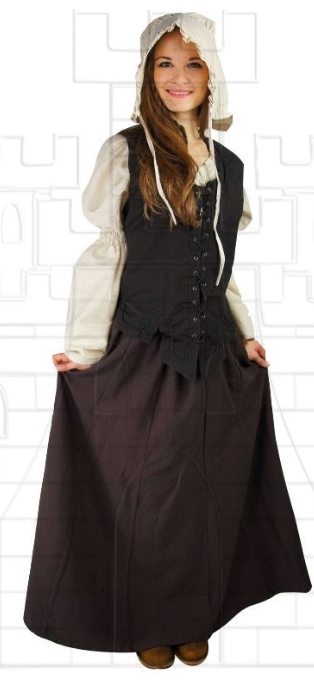
The Skirt in Men’s History: A Global Perspective
It is important to remember that, historically, the skirt has not been an exclusively female garment. In various cultures and eras, it has been worn by both men and women. However, in Western modernity, it has been designated more as a distinctly feminine garment, a perception far removed from its global and ancestral use.
Fortunately, some cultures have preserved and continue to use men’s skirts, challenging contemporary Western conventions. Notable examples include:
- The kilt of the Scots, Irish, and other Gaelic peoples, an iconic garment symbolizing heritage and cultural pride.
- The Tahitian pareo, a light and versatile garment used in the Pacific Islands, ideal for warm climates.
- The lava-lava of Polynesian and Oceanic cultures, similar to the pareo, worn by both men and women.
- The fustanella of Greeks and Albanians, a pleated skirt that is part of their traditional national costumes.
- The sarong, a wrap garment widely used in parts of Asia (such as Indonesia, Malaysia), the Arabian Peninsula, certain regions of Africa, and various Pacific islands, demonstrating the universality of the skirt as a garment for both sexes.
In short, the medieval skirt is much more than a simple garment; it is a tangible fragment of history, an eloquent reflection of a society with its hierarchies and values, and an artistic expression that continues to fascinate and inspire today. Its legacy endures in fashion, historical reenactment, and popular culture, proving that the elegance and meaning of these garments are far from forgotten. If you feel inspired by the majesty and charm of these historical pieces, we invite you to explore our collection.
At Medieval Shop, you will find a wide selection of women’s medieval skirts, ideal for reenactments, themed events, or to add a unique touch to your wardrobe. In addition, to complete your outfit, don’t miss our women’s medieval clothing and the perfect accessories for your medieval costumes, which will allow you to fully immerse yourself in the elegance of the Middle Ages.


